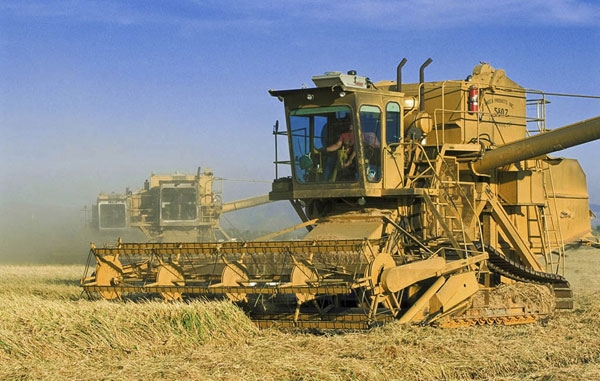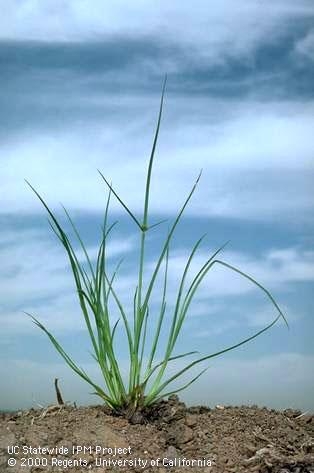Posts Tagged: Luis Espino
UCCE helps farmers protect rice crops from armyworm
Rice farmers are encouraged to monitor vigilantly for a rise in yield-reducing armyworms, reported Jake Abbott in the Appeal-Democrat.
UC Cooperative Extension rice advisor Luis Espino said the most recent numbers were low but are expected to climb in the next few weeks. The pest can quickly devour rice foliage down to the water level. The crop may recover, but armyworm presence can lead to yield reduction.
“I've heard numerous stories where growers were used to some defoliation and would go on vacation, and after the weekend they'd come back and see full defoliation," Espino said.
Espino and his team set traps at 15 locations across the valley to monitor pest populations weekly. The pheromone traps are small buckets that attract male moths. They take the information collected from the traps and notify farmers on whether or not they should begin examining their own fields for the presence of armyworms.
“We usually start to see numbers increase around mid-June and peak in late June or early July,” Espino said. “Right now, numbers are very low but they will come up. Over the years, we've learned that once we see the moth population peak, we see a peak of the worm population a week later. Once we start seeing those go up, we begin letting growers know to check their fields.”
Rice planting proceeds despite drought
Water uncertainties delayed planting of the California rice crop, but it finally began the last week of April, reported Tim Hearden in Capital Press. The National Agricultural Statistics Service predicts 408,000 acres to be planted to rice in California in 2015.
“Planting is going full swing right now,” said Luis Espino, UC Agriculture and Natural Resources (UC ANR) rice crop advisor with UC Cooperative Extension in Colusa County. “With the water situation early on, everyone was expecting water deliveries to be a little late — the first week of May. Then it was actually delivered a little earlier than that.”
Planting is about two weeks ahead of schedule in Butte County, said Cass Mutters, a UC ANR CE rice farm advisor.
“This spring was unfortunately so dry and so warm that growers were out working their fields,” Mutters said. “As a result, the planting schedule is accelerated this year.”
Because water deliveries from the Sacramento and Feather rivers have been cut, some land that typically produces rice will be fallowed in 2015.
“It's hard to say how much, but my guess is it's going to be maybe 10 or 15 percent more than last year," Espino said. "Growers might not get surface water but might be able to pump here and there or get water from somewhere else. We'll see at the end what the actual acreage is.”
California rice growers reduce greenhouse gas emissions
Butler is participating in a pilot program funded by the Environmental Defense Fund. Though it’s too early to measure, he has seen promising signs from the project.
“We’ve had good results with yield and water conservation, which really was our goal,” says Butler. “We’re happy that greenhouse gases go down as a result of that, but they weren’t the initial reason why we do that.”
Of the global GHG accumulation for all sectors, 0.001 percent comes from California rice fields, according to data compiled by Luis Espino, UC Cooperative Extension rice farm advisor for Colusa County.
“It’s such a new issue I don’t think much has been done in that area,” says Espino. “Right now UC Davis is doing the research, doing the modeling, trying to understand what goes on in the soil.”
Cass Mutters, UC Cooperative Extension advisor for Butte County, noted that California rice growers realize that being environmentally sensitive is part of their responsibility. Since the 1980s, changes in irrigation management and other practices have led to a 98 percent reduction in pesticide residues entering public waterways from rice fields. Along with water quality, the rice industry supports an air quality monitoring network that enables the Air Resources Board to model how many acres can be burned without exceeding federal air quality standards.
Rice harvest expected to be good
As California rice fields begin to be harvested this week, farmers and UC experts say the yield is expected to be good, but unremarkable, said an article by Ching Lee in the Central Valley Business Times.
"It looks like it's going to be an OK harvest," said Butte County rice farmer Michael Arens.
Yields should be "somewhat average," the article quoted Chris Greer, UC Cooperative Extension advisor for Yuba, Sutter, Placer and Sacramento counties.
A hot spell in August limited flowering in some cases, but the warm weather also helped control the fungal plant disease rice blast.
"In a year like this, unless we start getting heavy rains, (harvest) is probably going to turn out fairly good," Greer said.
A Chico farmer reported a problem with weeds this year. Luis Espino, UCCE advisor for Glenn, Colusa and Yolo counties, said UC researchers confirmed last year that smallflower umbrella sedge has become resistant to one of the main herbicides that growers use to control it.
"We'll probably see more of (the resistant weed) as time goes by," Espino said.
UC scientists identify herbicide-resistant sedge
UC scientists have confirmed that populations of smallflower umbrella sedge from rice fields in Sacramento County have become resistant to the widely used contact herbicide propanil, reported Western Farm Press.
Albert Fischer, professor, and James Eckert, staff research associate, both in the Department of Plant Sciences at UC Davis, collected smallflower umbrella sedge seeds from eight fields where resistance was suspected. They grew the weeds in pots, then sprayed them with propinal at half the field rate, the recommended rate and twice the field rate. The herbicide did not control the weed seeds collected at four of the fields. The seeds from the other four fields were well controlled by propinal.
Luis Espino, UC Cooperative Extension advisor, rice, said the field failures with non-resistant sedge could have resulted from mistakes in herbicide application. The propinal-resistant seed were also found to be resistant to several other herbicides.
To prevent weed resistance, Espino said, it is best to alternate modes of action whenever possible.






